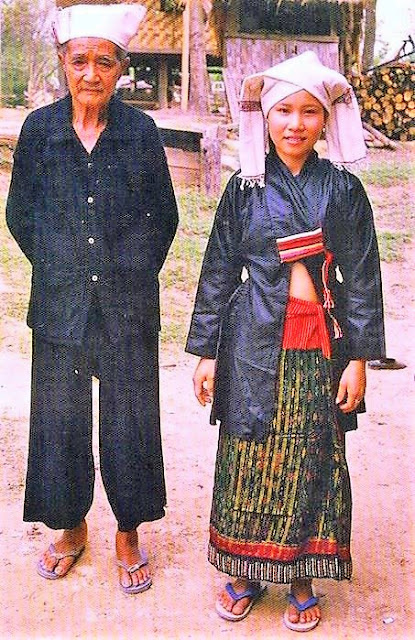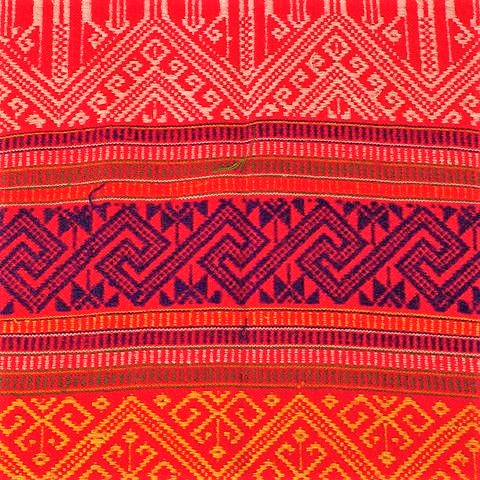Hello all,
Today I will talk about the clothing of the large family of the Tai peoples, which number a dozen or more main groups, and a larger number of small groups.
The photo above is of Queen Sirikit of Thailand, who had research done and codified a number of forms of Chut Thai, or Thai dress suitable for formal and other occasions, in a desire to encourage Thai culture.
The Central Thai people, or Siamese, are the most well known of this family, but there are many others, which are generally referred to as Tai.
The Tai - Kadai language family is divided into five branches, Kam-Sui, Kra, Be, Hlai and Tai.
The Tai branch is divided into three groups, North Tai, Central Tai, and Southwestern Tai.
The Southwestern Tai are further divided into four groups, as seen in this map.
Many of these peoples identify with an independent kingdom which existed in the past. These have now been assimilated into the modern macrostates. They speak languages which are distinct from those of their neighbors. I will attempt to cover most of these and their costume. The actual ethnic situation is very complicated, and the following is a simplification.
Pak Thai or Southern Thai
This is the most divergent Tai language, being spoken on the isthmus of Kra in the south of Thailand and Myanmar by about 5 million people. This is shown in red on the map above. This Tai group is unique in that a significant minority are Muslim, under influence of the Malay which live to their south. The Pak Thai language is used as a lingua franca by the minority peoples of the south as well. I have found little on the way of traditional costume except for the Muslim minority.
https://en.wikipedia.org/wiki/Southern_Thai_language
Chiang Saen Group
Central Thai or Siamese
This is the group which is meant by the term Thai, with an aspirated T. This group and language is dominant in today's Thailand; is the native language of about 20 million people, and is used as a second language by the other inhabitants of Thailand as well. Natively, Thai women wore the hip wrap with the ends pleated in front and held in place by a belt, the style which is known as pha naa nang, or with the ends twisted and passed through the legs and tucked in back, which is known as chong kraben, which may have been adopted from the Khmer. Queen Sirikit at the head of the article is wearing the first style. Today it is common to see Thai people wearing the phaa sin, a cloth sewn into a tube and then folded and tucked at the waist, but this was originally a northern style of the Tai Yuan and the Isan. A shoulder cloth, pha sabai is often worn, with or without a blouse or jacket on the torso. Among the Thai, the pha sabai is often pleated.
https://en.wikipedia.org/wiki/Thai_people
Tai Yuan
ไทยวน
These people are shown in medium blue on both of the following maps. This language has about 6 million native speakers. They are also known as Northern Thai, Lanna, or Khon Muang ฅนเมือง. They inhabit the territory of the former kingdom of Lan Na, in the northwest of Thailand, and some adjacent parts of Laos.
https://en.wikipedia.org/wiki/Northern_Thai_people
In this area, the cloths which are worn around the waist are first sewn into a tube, the warp being worn horizontally. This is called pha sin. This fashion has penetrated into the south as well, but started in the northern regions. A typical pha sin of the Tai Yuan has three parts, a plain waistband, a middle part which usually features horizontal stripes, and a wide border on the hem which is highly ornamented for dress, but may be left plain for everyday.
A sabai, or shoulder cloth was the original top garment. This was made of cloth which was plain or had an overall floral pattern, but did not have a fancy woven band design. Later on, a jacket which overlaps in front was adopted from peoples further north, notably the Tai Lue.
Men wore a similar cloth around the shoulders, and short pha chong kraben wrapped around their hips while being tattooed from waist to knees. A waist sash or belt was usually added. The aristocracy, of course, wore more ornamented outfits. A jacket was sometimes worn by men of the upper classes.
Today commoners have adopted plain shirt and pants, again from their neighbors to the north. Here is a scene from a temple ritual in Chiang Mai.
Phuan
พวน
Also called Tai Phuan or Lao Phuan, this is the first of what might be called the tribal peoples of this group. This language is spoken by perhaps 200,000 people. They trace their history to the independent principality of Muang Phuan, which in the 13th cent. was located in what is now the Xiang Khouang province of central Laos. This lay on a plateau between the Mekong river basin and the rivers which empty into the Pacific, centered on the city of Chiang Khwang. Many still live there, but many others of their people now live in scattered pockets in Laos, Thailand, and even Cambodia. This is the result of a combination of marauding Haw [Chinese Moslem] invaders from the north, and slaving expeditions by the Kingdom of Siam.
https://en.wikipedia.org/wiki/Phuan_people
Today the Phuan dress rather simply most of the time.
Here is a couple from Laos
And here is a couple from Thailand
Here are some older, more traditional outfits.
The Phuan are known as excellent weavers. Here are some examples of Phuan weaving.
The Phuan who live in Lan Na, specifically in Hat Sieo, Sukhothai province, and Laplae, Uttaradit province still weave pha sin with complex borders. These are similar to, but distinct from the ones woven by the Tai Yuan. Here is an image comparing the two. The Tai Yuan pha sin is on the left, and the Phuan pha sin is on the right. The embellished band extends to the hem and does not leave a band of red as the Tai Yuan do. This is followed by two more images of Phuan pha sin.
Peoples of Sip Song Chau Tai
สิบสองจุไทย
This is a region in northwest Vietnam which was independent or autonomous from at least the 15th century until 1954, when it was fully integrated into Vietnam. It often included adjacent parts of Laos. This was a confederation of the Tai Dam, Tai Khao, and Tai Daeng. In Vietnam they are considered to form the Thai ethnic group and number roughly 1.5 million all together.
https://en.wikipedia.org/wiki/Sip_Song_Chau_Tai
Tai Dam
ไทดำ
Also called Black Tai, or Thái Đen in Vietnam. They live in northwestern Vietnam, and adjacent parts of Yunnan and Laos. There are also small enclaves in Thailand, where they are known as Tai Song, or Tai Song Dam. The men wear black pants, shirts which open down the middle front and are fastened with frogs, and a black turban. Women today wear tight blouses with butterfly buttons, plain pha sin with a colored waistband, colorful head cloths, and either a metal belt or sash.
https://en.wikipedia.org/wiki/Tai_Dam_language
https://en.wikipedia.org/wiki/Tai_Dam_people
Tai Khao
Also called White Tai, Tai Dón or Thái Trắng in Vietnamese, and Dai Duan in Chinese. There seem to be about 500,000 speakers of this language. Originally the Black Tai women wore black blouses with high necklines, and the White Tai women wore white blouses with V necklines. Today both wear blouses of various colors. The outfits worn are very similar.
https://en.wikipedia.org/wiki/Tai_D%C3%B3n_language
https://en.wikipedia.org/wiki/Tai_D%C3%B3n_people
Tai Daeng
Also called Red Tai, or Thái Đỏ in Vietnamese. They number about 100,000. Many speakers of this language in Vietnam identify as Tai Muang, Tai Thanh, Tai Dam, or other. The use of the term Red Tai in Vietnam is contested.
https://en.wikipedia.org/wiki/Tai_Daeng_language
https://en.wikipedia.org/wiki/Tai_Daeng_people
These people make various versions of pha sin, but one distinctive kind is mostly plain with a wide, figured decorative hem another has woven in ornament over most of the garment.
Here is a family of Tai Muang Daeng from Vietnam wearing contemporary blouses with traditional pha sin.
This is a group from Quan Son district, Thanh Hoa province in Vietnam. They identify as 'Black Tai' but form part of this group. As in many ethnic groups, costume varies by district or even village. They are wearing traditional breast covers over modern blouses.
The following images are from Laos.
Some examples of Tai Daeng weaving are spectacular.
This concludes part 1. In part 2 I will cover the rest of the major Southwestern Tai Peoples
Thank you for reading, I hope that you have found this to be interesting and informative.
Roman K.
email: rkozakand@aol.com
Source Material:
Queen Sirikit of Thailand, 'Satree Thai; Costumes of Ancient Thai Ladies', Bangkok,
Susan Conway, 'Thai Textiles', London, 1992,
Susan Conway, 'Silken Threads Lacquer Thrones; Lan Na Court Textiles', Bangkok, 2002
Gittinger & Lefferts, 'Textiles and the Tai Experience in Southeast Asia', Washington, D.C., 1992,
Patricia Cheesman Naenna, 'Costume and Culture; Vanishing Textiles of some of the Tai groups in Laos', Chiang Mai, Thailand, 1990
Joachim Schliesinger, "Tai Groups of Thailand', Bangkok, 2001
Joachim Schliesinger, 'Ethnic Groups of Laos', Bangkok, 2003
Joachim Schliesinger, 'Ethnic Groups of Cambodia', Bangkok, 2011
Michael and Kim Howard, 'Textiles of the Daic Peoples of Vietnam', Bangkok, 2002
Prangwatthanakum and Naenna, 'Lan Na Textiles - Yuan Lue Lao', Bangkok, 1990
Nguyen Van Huy et al, 'The Great Family of Ethnic Groups in Vietnam', Vietnam, 2011














































































This article is amazing. You put a lot of work into researching this, I really learned a lot. It's very nice to see cultural fashion sorted according to language history rather than regional location, as this makes it easier to see the evolution of each style and how they relate to each other. I will certainly be reading through many of the articles on your blog. Thank you so much!
ReplyDelete